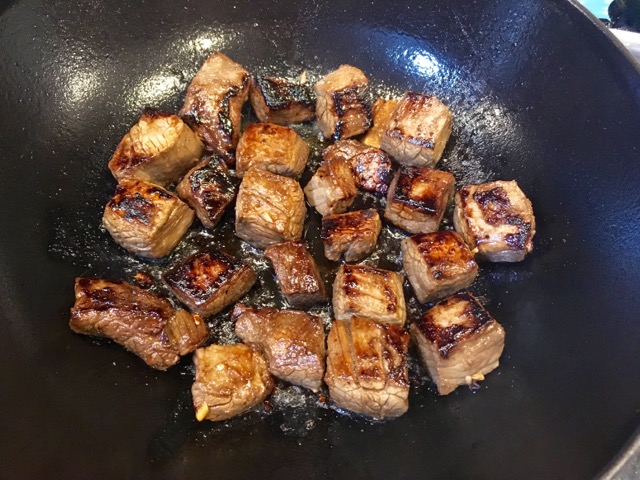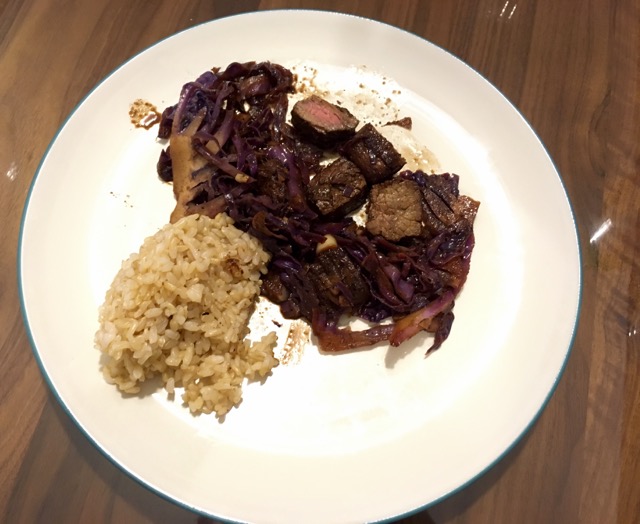Obviously, these are not actually teriyaki strips; they’re teriyaki chunks, because the butcher kindly offered to cut my flank steak into pieces for me, and I didn’t realize he’d chopped it into cubes instead of longer slices until it was too late. Quel dommage—or however you say that in Japanese, I guess.
Not that Nonnie’s teriyaki is particularly Japanese. Actual teriyaki sauce has just three ingredients—soy sauce, sugar, and saki or mirin, a sweeter rice wine. Her take swaps the mirin for dry vermouth—because even though I’m sure you could find Japanese products in Los Angeles grocery stores in the 70s and 80s, my grandmother never met a recipe she couldn’t add vermouth to—and also incorporates dried onion (another favorite; can’t make vaguely Japanese food without giving it a bit of that shtetl flavor, I guess), beef bouillon, lemon juice, and ginger (which she charmingly called “gingerroot,” as was, I suppose, the style at the time). And rather than reducing these ingredients to make a beautifully glossy sauce, Nonnie just uses them as a marinade—one that, granted, is given plenty of time to penetrate the meat, but still won’t have as much of an impact as something reduced on the stove and passed table-side.
That said, it’s tough to mess up anything as elemental as beef soaked in soy sauce. And while Nonnie’s doesn’t quite measure up to my favorite teriyaki—which is not anything I ate when I actually went to Japan, but the chicken I’d devour at our local sushi place until the age I decided I wasn’t grossed out by the idea of sushi anymore—it’s perfectly serviceable. Even when inadvertently botched by a knife-happy butcher.
Teryiaki Strips
1 flank steak, cut diagonally into 1″ strips
1 cup dry Vermouth
1 cup soy sauce
1.5 tablespoon dried onion flakes
1 garlic clove, minced
2 tablespoons lemon juice
2 tablespoons brown sugar
1 can beef bouillon [Do cans of bouillon like… exist anymore? I came up empty after looking in two grocery stores, so I ended up buying this weird-looking jar of “roasted beef base” and using some of that instead. It was fine!]
1″ piece gingerroot, crushed
Place meat in shallow baking dish. Mix all other ingredients together. Pour over meat. Cover and refrigerate overnight. [Thanks, I would guess, to the acid in the marinade, this long bath will leave some of your meat looking decidedly grey on day 2; it’ll still taste fine, but the visual isn’t exactly appealing.]
Cook over high heat, quickly, in skillet or barbecue, or cook in wok. [I used a wok—I browned my cubes on all sides and then cut inside, and was pleased to find that most of them still had a bit of pink at the center. That’s one benefit of cubes over strips, I guess; you’re less likely to overcook thicker pieces of beef.]
The verdict: Again: it was fine! The flavor was more sweet soy than a real teriyaki; if I made this again, I’d reserve some of the marinade and use it to make a sauce. I don’t think it would have turned out all that differently if I’d actually had strips of beef instead of cubes, but then again, who knows; more surface area on each piece would have at least meant more charred and crispy ends, which everyone knows is usually the best part of a steak.
So I’ll try that next time as well, if there is a next time—though honestly, I’d rather make this sauce altogether, and ditch the vermouth-bouillon-lemon combo.






